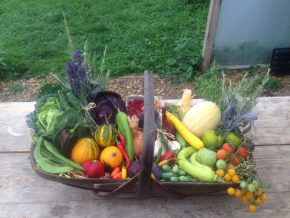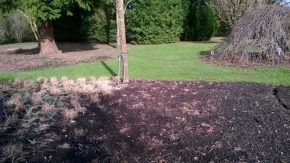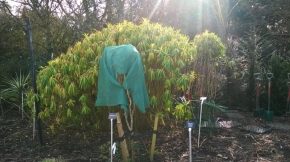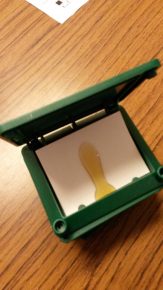Excerpts from Trainee Journals
As part of their assessment, our trainees keep a journal of their placements. This allows them to reflect on their learning, as well as being a useful working document to remind them about plants and procedures.
The extracts below – reproduced with our trainees’ permission – give a feel for what day-to-day life is like on our placements.
Matthew Clegg, Aberglasney, 2016-18
10th January 2017
Weather: 10/6˚C, overcast and mild
Tasks:
- Continuing mulching with the Melcourt Bark on Bishop Rudd’s Walk (With JD, KM, T & H)
- The beginning of the mulching was very disorganised with mulch being put in different positions and we were trying to use wheelbarrows and boards to get mulch to the back.
- However, within the first hour of this we identified that the chain method was most effective and caused less damage then the heavy wheelbarrows and boards.
- KM, T and myself were working in a team and by lunch we were extremely efficient. The team was using the following method:
– 1 or 2 people filling the buckets
– 1 to 3 people passing full and empty buckets the appropriate ways
– 1 or 2 people in the bed to cause least amount of damage - After the slow start we managed to progress well up Bishop Rudd’s Walk, thanks to the chain method.


Before and After images of the mulching
Fred Stratford, Audley End, 2016-17
Saturday 24th September 2016
Weather: Warm, pleasant weather of 22′.
The first day of Apple Weekend! Quite a few small jobs in the morning to perfect the site before visitors arrived. Anna and I arranged the large trug with produce, put out some more straw behind the pear trees by the squash patch, set up the children’s activities tables with Catherine and set out the markers for the apple trail, and I watered the dahlia border to keep it looking well for the weekend.
I finished hoeing and raking the central iris path with Trish before break, then started peeling, coring and spiralling apples for children, which they found really exciting – some children didn’t want to stop using the machines. There was also apple bobbing and the apple trail around the orchard, with Discovery apples as prizes which went down very well once kids knew about the pink colour of the apple flesh.
There were several juicings throughout the day – lots of children were very keen to help, so Sam and I supervised them on the safe parts of juicing like turning the grinding wheel. It was lovely to see so many people enjoying Audley End and to get to talk to them.

Sunday 25th September
Weather: Rain when we arrived at work, slowly improving to warm sunshine by 2pm.
Day 2 of the Apple Festival. After a meeting to check everyone’s Saturday and what needed doing for the day (such as which varieties of apple had sold well and needed picking) Catherine and I set up the children’s activities and then picked unblemished apples for bobbing and for peeling – they were mostly Queen Cox, which had plenty of fruit and much of it small.
Visitor numbers were low in the morning, perhaps due to the cooler, greyer weather, but by mid-afternoon there were queues of up to 10 people waiting to have a go on the apple peelers with Peggy and me. Events reported that 1900 people visited yesterday. Did ident test at lunchtime.

Wendy Watson, Mount Stewart & Rowallane Gardens 2015-17
Friday 8th September 2016
Heavy showers – 16°C
I was given 4 ant traps which I set up and placed in various parts of the garden. These have been sent by the University of York in order to determine the spread, if any of the invasive ‘super ant’ that has established colonies at Hidcote. This is an ant survey across NT properties.
These ‘super ants’ are threatening the survival of native ants and causing damage to plants due to their aggressive herding of aphids. They are difficult to distinguish from the common black ant.
The traps are hinged to enclose a sticky card with honey bait. I placed them in areas where ants have been seen on the property, set them out of sight and weighted them down. In 3-5 days I will collect them, seal them in bags and place in the freezer for 12 hrs before sending them back for identification.
Today was spent potting on many plants in the nursery as well as potting up bulbs.
Fritillaria persica ‘Alba’ bulbs were potted up – the bulbs are quite large, about the size of my clenched fist. They were placed in a long tom pot, filled with 1/3 compost/peat mix followed by a layer of course grit for drainage 15cm. The bulbs were placed on their sides to avoid water entering the holes on the top and rotting the bulb. They were then filled with compost to the top, NOT watered and placed in the shade tunnel and covered with enviromesh to protect from rodents. Flowering time – April/ May – height 75cm

Jenny Swatton, Sir Harold Hillier’s Gardens, 2015-16
Monday 29th February 2016
Weather: Daytime high 8.30C. Daytime low -20C. Wind light and variable. Sunshine.
Today I returned to the Centenary Border, working with Richard (Horticulturalist). Despite the light frost, we began by using border forks to spike and aerate the heavily used grass paths. This was a task which I carried out last time I worked on the Centenary Border. The ongoing need to carry out this work, highlights the difficulty of managing grass paths in winter, in a garden which receives 170,000 visitors per year.
Next, we worked on combing out/ cutting back Hakonechloa macra ‘Aureola’ and weeding around the plants. Ideally, we would have combed out these deciduous grasses, but they were only planted last spring, and the roots are not very well established. Because of this, we could not comb too vigorously as there was a risk of disturbing the roots, and so had to use shears to trim the remaining blades.

In the afternoon, we moved / removed twelve Euphorbia mellifera. To handle these large plants, the stems were drawn together with a rope, and then a spade was used to root ball the plants (technique described previously). For the plants which were being removed completely, we could then use a fork to remove most of the soil from the roots to make them lighter to handle. To help the plants which were being replanted to re-establish, we avoided disturbing the rootball and retained as much soil as possible.

Ellie Dunn, Wrest Park 2014-16
W/c 30th March 2015
Monday
Evergreen garden – edging and mowing
Tam explained how to use the edging shears, holding the left hand still, moving the right hand to cut. Using them at just a slight tilt.
Sheila gave a demonstration of how to deal with the grass that is growing out into the bed. She pushed the cut grass aside with the blades so she could see the edge. She was only cutting with the outer end of the blade. She pushed the blades into the soil enough to cut the grass growing horizontally out down at soil level. Other bits of grass actually rooted in the bed were pulled out as the cut grass and weeds were cleared up.
I think it is important not to tilt the shears too much as you then lose the effect of a square edge.
I was able to do this where there was some edge to follow i.e. a drop from the grass surface down to the soil in the bed, but it’s frustrating to try to use the shears where there is no change in level between the grass and the soil.
Mowing with the Hayter 48 around the beds. Setting 4 used as the grass was quite long. It was efficient to have barrow bags strategically placed to empty into as I passed, rather than waiting for the grass to start spilling out and then to also have to carry the collection box somewhere to empty it.
Tuesday
Gales overnight meant that the woodland garden was ‘out of bounds’ today.
The wind had loosened the curly-leaved ivy – is this Hedera helix ‘Parsley Crested’? – that had been trimmed into a neat square recently. It had flopped down and was like a large heavy mattress that someone had given up trying to turn over. We cut it into sections to remove it. I finished it by cutting it back to about a foot.


Beginning of season meeting
Dump – Took a mixed load of burnable and non-burnable stuff to the dump which cleared the trailers at the end of the day but it took longer to manually unload in two different locations.
Evening – helping with the stocktake in the shop.
Francis Keeting – Threave 2010/11
Task Description: Before morning break I worked with Asia lifting Dahlia ‘Bishop of Llandaff’ tubers in the walled garden. The tubers are lifted and stored in the potting shed over the winter to prevent them rotting in the ground (see Fig. 2.8) – they do not tolerate cold, damp weather. We removed the stems of the dahlias first and then used a fork to gently lift them from the ground. We removed as much soil as we could from around them and disposed of any unhealthy looking tubers. Inside the potting shed the tubers were placed upside down on slatted shelving underneath the bench, this is to aid the drying out process. After a few weeks the tubers will be cleaned again, to help prevent rotting, and then placed the correct way up on the shelves. Through the winter they will be misted from time to time to prevent them desiccating.
I spent the rest of the day continuing the cutting of the Tsuga hedges in the walled garden. I also trimmed three shaped Taxus baccata trees growing there. I cut the tops of several of the hedges from specially erected scaffolding (see Fig. 2.5). Brian Mc set up the scaffolding as he is qualified to do so and he also had to be present when the scaffolding was moved to ensure this was done safely. Important points about the scaffolding:
- the scaffolding is on castors to allow it to be moved easily, the castors have brakes that must be applied before the scaffolding is climbed
- The outrigger poles should be at an angle of 45° when the scaffolding is in place to ensure maximum stability.
- These poles are lifted and moved in line with the scaffolding when it is being moved.
- Climbing the outside of the scaffolding is forbidden.
- Ensure the trapdoor in the scaffold platform is properly shut before starting work.
- Check platform is level (use a spirit level) before starting work.
I found using the scaffolding much more comfortable than using the ladder and it also felt much safer. There is room to move around and much less twisting involved. It is more time consuming to use than the cage but it’s quieter and more comfortable to use and requires less people.
Plant Information: Tsuga heterophylla 20-40×6-10m – Conical evergreen conifer producing very glossy, dark green leaves. Grow in humus rich, moist but well-drained soil in full sun or shade. Shelter from strong winds. Propagate by seed in spring or semi-ripe cuttings in late summer or early autumn.
Task Description: Today we finished cutting the hedges in the walled garden and we also cut the Taxus baccata hedge outside the secret garden. I had the opportunity to use a pole cutter – a hedgecutter on a long pole – to cut the top of one of the hedges and also the tops of the shaped Taxus trees (see Fig. 2.6). The pole cutter is heavy and generates a lot of vibrations so it can only be used for short periods of time. A harness can be worn to make using the machine more comfortable.
Ondina Mulundo – Hampton Court 2010/11
Bedding out: There are 14 circular plant beds in this area surrounded by lawns. The size of the plant bed is about 15x8m. The soil has being raised, which gives height and makes the plant scheme stand out on this side of the garden which is quite flat.
Comments: This task has different stages, the first one the satisfaction of creating a planting scheme with a variety of shapes and texture and to see how beautiful they look as they grow. The second one was improving my knowledge of how to work with a variety of plants using pattern and mixed random planting within the same scheme, with a spectacular results. The third one is you get to feel most of the muscles in your body particularly in your back and the knees. I think it would help if we could have other tasks in between, however as I know being a horticulturist is not always possible select the tasks to please the work force.
Shaping the circle of the trees, removing hederas from the wall, digging out the Malus trees using a fork to loosen up the soil around the roots and dig out the tree using the spade. Collect all the plant waste and take to the recycle area.
Scarifying the lawn, clearing the area of litter and debris such as sticks and large stones:
Turf scarifiers are used to remove the build up of thatch on the surface of the lawn. This is done to remove moss and weeds and clippings from the lawn. It stops the lawn from being compacted and helps oxygen, water and fertilisers to reach the roots of the grass. Scarification also encourages the grass to produce side shoots which will lead to a denser lawn.
Strimmer, scarifier, barrow, spade, rakes and besom: The tasks were very satisfying, I enjoyed the dynamic of performing different tasks in the same day. Doing these tasks help to improve my practical knowledge and the satisfaction to see how well and easy I can do these tasks. In the end of the day I could see the transformation in the garden and knowing that I made happen.
Nereida Martin-Fabregas – Myddleton House 2010/11
Monday, 27th September 2010.
Light showers early in the morning. Dry and cool in the morning and mild in the afternoon.
TASKS:
7.30 – Take Temperatures in glasshouses and conservatory.
MOVE SUCCULENTS with Bryan and Nicola. They are not hardy enough to survive the winter temperatures and dampness. We put the small plants in trays and the bigger ones in pots.
Nicola and I finished off the bed by MOVING AND REPLANTING some of the Ajuga repens making an homogenous straight line at the bottom of the bed, just at the edge. The Ajuga line stops the soil coming down the bed and falling into the road.
James Miller – Beningbrough Hall and Gardens 2010
Sunday, September 26th 2010. Green Festival.
This involved assisting in apple pressing, using mainly windfalls of both apples and pears, Pyrus domestica. Due to the exceptionally large crop of apples this season we could thin out a large amount of smaller apples from a Kent variety Malus domestica ‘Orange Goth’. The apple pressing activity proved particularly popular with the public, involving children with the operation of the apple press. Once the fruit has been chopped and put through a crusher it is then pressed and the juice is passed through muslin to remove any large partials. Obviously this task requires careful supervision when it involves members of the public. The fresh juice from this activity can then be given away to the public.
Tamara Bridge – Sandringham 2010
29.10.10
Weather: Dry
Location: PG
Daily routine and areas of responsibility: Arrive 7:30am, break 9:30am, lunch 12:30pm, leave 4:15pm.
Tasks undertaken 7:30-11:15: Cutting down herbaceous near upper lakes using a strimmer to get rid of worse stuff then tidying up behind with rake and secateurs.
Machinery/ tools used: strimmer, tractor and trailer.
Horticultural interest: Primula vialli, upright stalk with an orchid like spike of lilac flowers, likes bog ground still flowering very pretty.
General observations: Taxodium distichum looking great by water.




